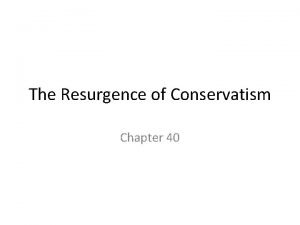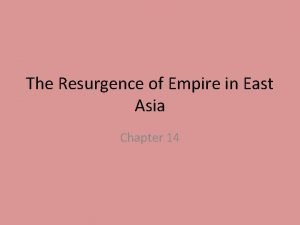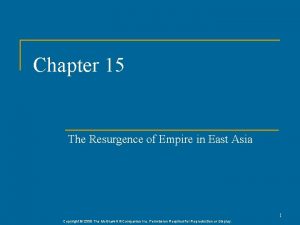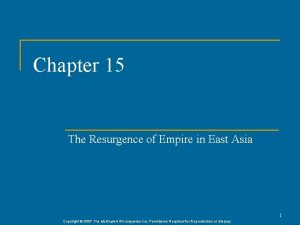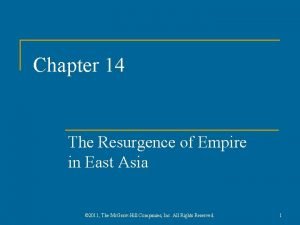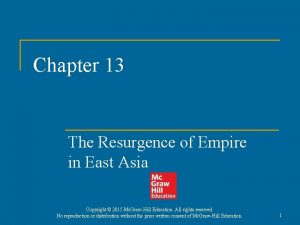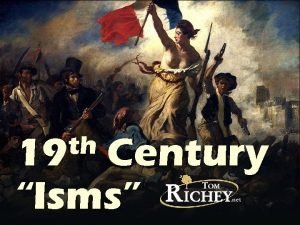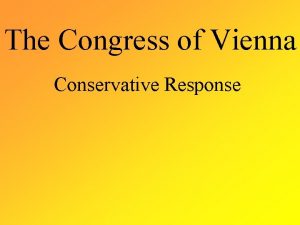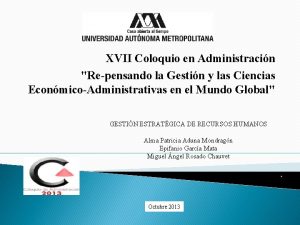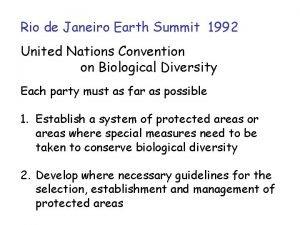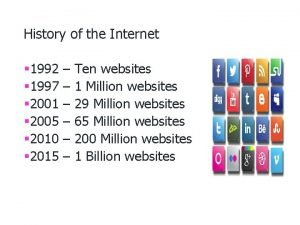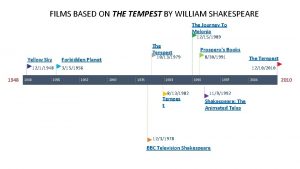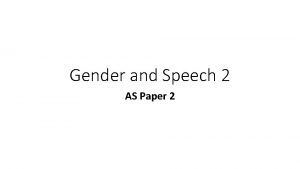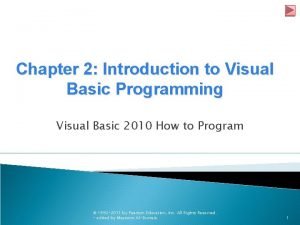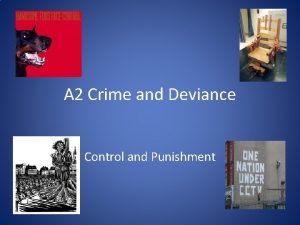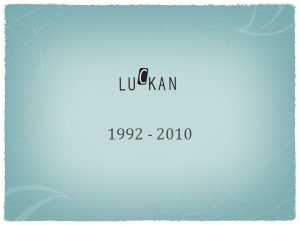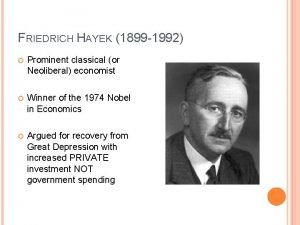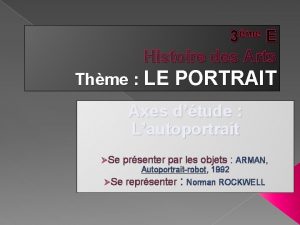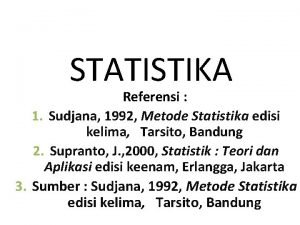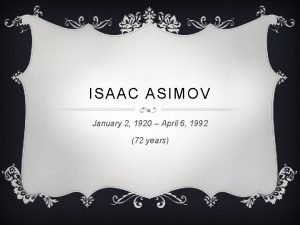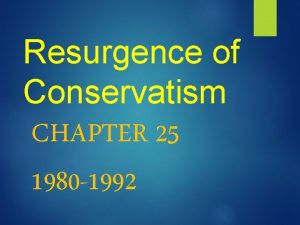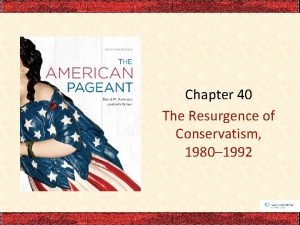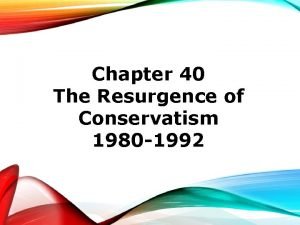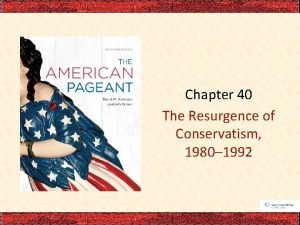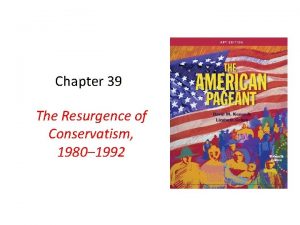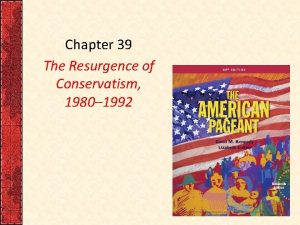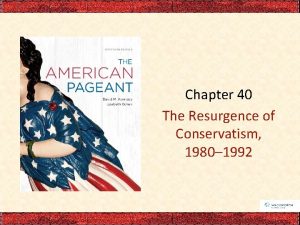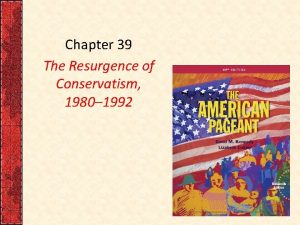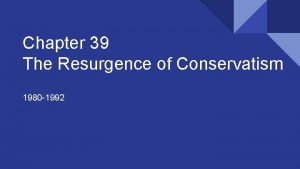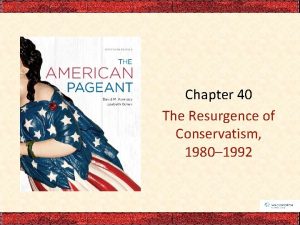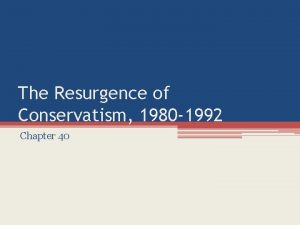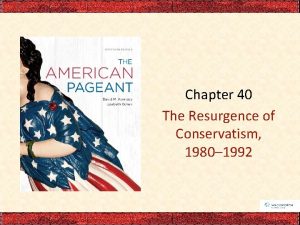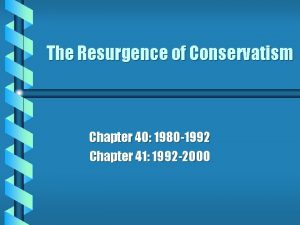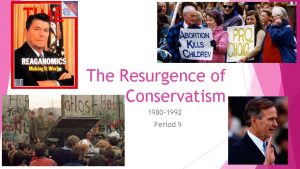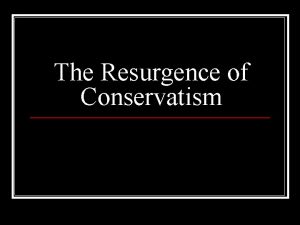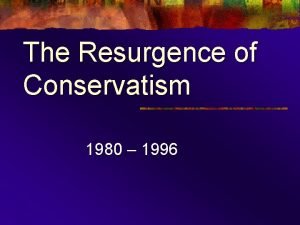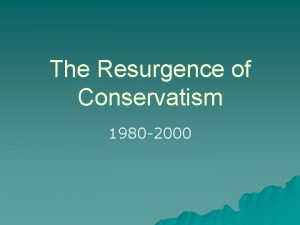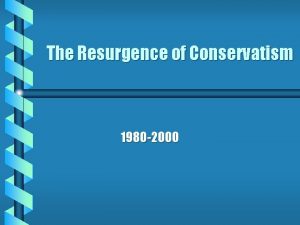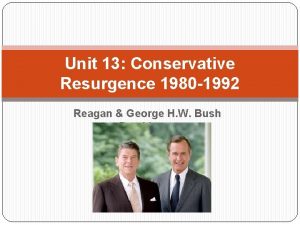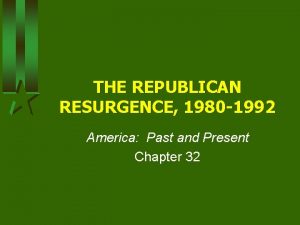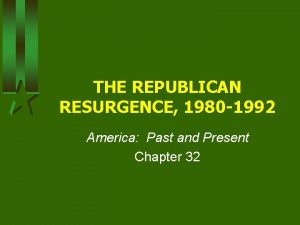Chapter 39 The Resurgence of Conservatism 1980 1992
























































- Slides: 56

Chapter 39 The Resurgence of Conservatism, 1980– 1992

I. The Election of Ronald Reagan, 1980 – Reagan's philosophy: • Sided with New Right on social issues • Denounced activist government and failed “social engineering” of 1960 s • Championed “common man” against big government • Condemned: federal intervention in local affairs, • Favoritism for minorities • Elitism of arrogant bureaucrats • Aimed to win working-class and lower-middle-class white voters from Democratic party

I. The Election of Ronald Reagan 1980 (cont. ) • Started in radio (1930 s), then moved to film (1940 s) • President of Screen Actors Guild during Mc. Carthy era of early 1950 s: – Helped purge communists and suspected “reds” from film industry • 1954: became spokesman for General Electric – Began to abandon his New Dealish political views – Increasingly preached conservative, antigovernment line • Backed by wealthy California businessmen, served as governor of California (1966 -1974)

I. The Election of Ronald Reagan 1980 (cont. ) • Jimmy Carter's administration struck many Americans as bungling and befuddled – – Disaffection with Carter even within Democratic party “ABC” (Anybody but Carter) movement Liberals turned to Senator Edward Kennedy Carter won nomination, but Democrats badly divided • Republican candidate Reagan – Attacked Carter's fumbling performance in foreign policy – Blasted “big-government” philosophy of Democrats – Carter's spotty record (galloping inflation, faltering economy) no defense against Reagan's popular appeal

I. The Election of Ronald Reagan 1980 (cont. ) – Election results: • 51% of popular vote for Reagan, 41% for Carter • 7% voted for liberal Republican congressman John Anderson • Electoral count 489 for Reagan; 49 for Carter • First elected president to be unseated by voters since Herbert Hoover in 1932 (see Map 39. 1) • Republicans gained control of Senate for first time in twenty-six years

I. The Election of Ronald Reagan 1980 (cont. ) – Carter's farewell address: • Stressed his efforts to scale down arms race, to promote human rights, and to protect environment • Signed bill preserving some 100 million acres of Alaska for national parks, forests, and wildlife refuges • Well-meaning, but hampered by lack of management talent and buffeted by events beyond his control • Later admired for humanitarian and human rights activities • Received Nobel Peace Prize in 2002

II. The Reagan Revolution • Reagan's arrival in Washington was triumphal – Iranians released hostages on Jan. 20, 1981— Reagan's Inauguration Day—after 444 days of captivity – Reagan's ideas: • Devoted to fiscal fitness • Sought to dismantle welfare state and reverse political evolution of past 50 years • Assembled conservative cabinet of “the best and the rightest”

II. The Reagan Revolution (cont. ) • His conservative crusade for: – Smaller government, less bureaucracy, and freer markets – “Reaganomics” – Found ally in Conservative Margaret Thatcher, Great Britain's Prime Minister: » She worked to reduce power of labor unions and government involvement in business » Two of Reagan's chief goals – They strengthened Anglo-American alliance of foreign policy – Their common refrain was » Free markets make free people and » Shrinking government meant keeping their nations safer from communism

II. The Reagan Revolution (cont. ) • Federal budget: – In 1960 s and 1970 s, federal spending increased from 18% of GNP to nearly 23% – Shifted from defense to entitlement programs, including Social Security and Medicare – 1973: budget of Department of Health, Education, and Welfare surpassed Department of Defense • Proposition 13: – – California tax revolt in 1978 Slashed property taxes Forced painful cuts in government services “Tax quake” jolted other states and helped Reagan's election

II. Reagan Revolution (cont. ) – Reagan's smaller-government policies: • Proposed budget with $35 billion in cuts: – Mostly in social programs—food stamps, job-training centers – Largest pillars of welfare state (Social Security and Medicare) untouched • Wooed group of mostly southern conservative Democrats (dubbed boil weevils) to abandon their party's leadership and follow Reagan • Reagan's political hand strengthened after failed assassination attempt in March 1981 • His success demonstrated power of presidency

III. The Battle of the Budget – Congress swallowed Reagan's budget proposals – Second part of his economic program called for • Big reductions in marginal tax rates over three-year period • Congress approved set of far-reaching tax reforms: – Lowered individual tax rates – Reduced federal estate taxes – Created new tax-free savings plans for small investors • Reagan's supply-side economics: – Combination of budgetary discipline and tax reduction would stimulate new investment, boost productivity, foster dramatic economic growth, and eventually reduce federal deficit

III. The Battle of the Budget (cont. ) – Economy slid into deepest recession since 1930 s Unemployment reached almost 11% Businesses folded Bank failures jolted entire financial system Automobile industry reported massive losses Anti-inflationary “tight money” policies that led to “Reagan recession” of 1981 -1982 had been launched by Federal Reserve Board in 1979 • Democrats charged Reagan's policies hurt poor while favoring rich • • •

III. The Battle of the Budget (cont. ) • Supply-side economics seemed vindicated when economic recovery began in 1983 – For first time since WWII, income gaps widened between richest and poorest Americans – Middle-class incomes largely stagnated • Symbolic was emergence of “yuppies” – Young, urban professionals (about 1. 5 million) made nearreligion out of conspicuous consumption – Showcased materialism and pursuit of wealth that came to symbolize high-rolling 1980 s

III. The Battle of the Budget (cont. ) • Key source of economic upturn was massive military expenditures: • Reagan cascaded $2 trillion dollars to Pentagon • Asserted need to close “window of vulnerability” in arms race with Soviet Union • Federal budget deficits ballooned • Massive government borrowing to cover deficits kept interest rates high and pushed dollar to record highs • Trade deficit grew as high dollar crippled U. S. exporters • Americans became world's heaviest borrowers

IV. Reagan Renews the Cold War – Denounced Soviet Union as “focus of evil in the modern world” • Believed in negotiating with Soviets only from position of overwhelming strength • Enormously expanded U. S. military capabilities • Pursued high-technology missile-defense system called Strategic Defense Initiative (SDI) • Battle stations in space that could fire lasers or other energy beams to vaporize intercontinental missiles on liftoff • SDI fit Reagan's strategy of threatening USSR with fantastically expensive new round of arms race

IV. Reagan Renews the Cold War (cont. ) • Relations with Soviets nosedived in late 1981 • Polish government imposed martial law against “Solidarity”, massive union movement of workers – Reagan placed economic sanctions on Poland USSR • Dealing with Soviets further complicated by ill health of aging oligarchs in Kremlin – Three of whom died between late 1982 and early 1985

IV. Reagan Renews the Cold War (cont. ) • Relations worsened in September 1983 – Soviets destroyed Korean passenger plane that violated Soviet airspace – Hundreds killed, including some Americans • By late 1983, all arms-control negotiations with Soviets ended • Chill of Cold War deepened in 1984 – USSR and Soviet-bloc athletes boycotted Olympic Games in Los Angeles

V. Troubles Abroad • Middle East remained volatile – Israel strained friendship with U. S. A. • As new settlements established in occupied territory of Jordan River's West Bank (see Map 39. 2) • Invaded Lebanon in June 1982 – To suppress bases from which Palestinian fighters harassed Israel – Reagan sent U. S. troops to Lebanon in 1983 as part of international peacekeeping force – Withdrew troops after suicide bomber crashed explosiveladen truck into U. S. Marine barracks on Oct. 23, 1983 » Killed more than 200 marines

V. Troubles Abroad (cont. ) • After Reagan suffered no political damage from incident, opponents began to call him “Teflon president” – Central America • Leftist, anti-U. S. A. revolution deposed long-time dictator of Nicaragua in 1979 • Reagan accused Sandinistas of using Nicaragua as base for Soviet and Cuban penetration of Central America • Reagan's administration officials claimed Nicaragua shipped weapons to revolutionary forces in El Salvador

V. Trouble Abroad (cont. ) • Reagan sent military “advisers” to prop up pro. American government in El Salvador • Provided covert aid, including CIA-engineered mining of harbors, to rebel contras in Nicaragua – Who opposed Sandinista government • October 1983, Reagan dispatched invasion force to island of Grenada: – Where military coup had killed prime minister and brought Marxists to power – Demonstrated Regan's determination to assert U. S. dominance of Caribbean (see Map 39. 3)

VI. Round Two for Reagan – Election of 1984: • Reagan met little opposition for second term • Democratic candidate was Walter Mondale – Made history by naming Congresswoman Geraldine Ferraro of New York as running mate – First woman to appear on major-party presidential ticket – Mondale's candidacy tainted by having been Carter's VP • Election results: – Reagan: 525 electoral votes to Mondale's 13—won all but Mondale's home state Minnesota and District of Columbia – Popular vote Reagan— 52, 609, 797; Mondale— 36, 450, 613

VI. Round Two for Reagan (cont. ) • Reagan's First term objectives: – Shrink federal government – Reduce taxes • Second term – Foreign policy dominated • Contended with Mikhail Gorbachev, installed as chairman of Soviet Communist party in March 1985 • Gorbachev personable, energetic, imaginative, and committed to radical reform in Soviet Union

VI. Round Two for Reagan (cont. ) – Glasnost –“openness”: – Ventilate secretive, repressive stuffiness of USSR – Introduce free speech and measure of political liberty – Perestroika—“restructuring”: – Revive moribund Soviet economy – By adopting free-market practices—profit motive and end to subsidized prices—of capitalist West – Two programs required Soviet Union: – Shrink enormous military machine – Redirect energies to civilian economy • End to Cold War thus required – Gorbachev made overtures to West

VI. Round Two for Reagan (cont. ) – Announced (April 1985) USSR would cease to deploy INF (intermediate-range nuclear forces) targeted at Western Europe pending agreement on complete elimination – Pushed this while meeting with Reagan at first summit meeting, in Geneva (Nov. 1985) – Second summit, Reykjavik, Iceland (Oct. 1986), Reagan stormed out because convinced Gorbachev wanted to end SDI – Third summit, Washington, D. C. (Dec. 1987), two leaders signed Intermediate-Range Nuclear Forces Treaty: » Banned these missiles from Europe – Final summit, Moscow (May 1988) capped their new friendship – Two leaders joined together to end Cold War » For this, history would give both leaders high marks

VI. Round Two for Reagan (cont. ) – Other decisive foreign policy moves by Reagan: • Backed Corazon Aquino's ouster of dictator Ferdinand Marcos, Philippines (Feb. 1986) • Ordered air raid against Libya in 1986 – Retaliation for alleged Libyan sponsorship of terrorism – Including bomb blast in West Berlin that killed a U. S. serviceman

VII. The Iran-Contra Imbroglio – Two problems seemed insoluble to Reagan: • Continuing captivity of American hostages, seized by Muslim extremists, in Lebanon • Continuing grip on power of Sandinista government in Nicaragua – Reagan repeatedly requested military aid for contra rebels fighting against Sandinista regime – Congress repeatedly refused – Administration obsessed with finding means to help contras – Some officials saw linkage between two problems: » Middle Eastern hostages and Central American Sandinistas

VII. The Iran-Contra Imbroglio (cont. ) • 1985: U. S. diplomats secretly arranged arms sales to Iran • In return, Iranians helped obtain release of at least one American hostage held by Middle Eastern terrorists • Money Iran paid then diverted to Nicaraguan rebels • Actions violated congressional ban on military aid to Nicaraguan rebels • As well as Reagan's repeated vow he would never negotiate with terrorists • U. S. A. continued to support Iraqi dictator Saddam Hussein by selling weapons for use against Iran • Nov. 1986: news broke of these secret dealings

VII. The Iran-Contra Imbroglio (cont. ) • Iran-Contra affair: – Reagan claimed innocence and ignorance – Investigation condemned administration's “secrecy, deception, and disdain for the law” – Cast dark shadow over Reagan's foreign policy record – Obscured his achievement in establishing new relationship with Soviet Union – Yet he has remained among most popular presidents in modern American history

VIII. Reagan's Economic Legacy – Reagan vowed to invigorate economy by: • Rolling back government regulations • Lowering taxes • Balancing budget – He did: • Ease many regulations • Push major tax reforms through Congress 1981, 1986 • Balanced budget remained grotesquely out of reach

VIII. Reagan's Economic Legacy (cont. ) – Supply-side economics: • Promised lower taxes would increase revenue by stimulating economy • Combination of tax reduction and increased military spending opened vast “revenue hole” of $200 billion annual deficits • In Reagan's eight years, he added $2 trillion to national debt (see Figure 39. 1) – More than all his predecessors combined

VIII. Reagan's Economic Legacy (cont. ) – Deficits represented economic failure, but political triumph for Reagan – He wanted to slow growth of government – Huge deficits made new social spending unlikely – Another legacy of 1980 s: – Sharp reversal of long-term trend toward more equitable distribution of income – Increased squeeze on middle class (see Figure 39. 2) – Early 1990 s, median household income declined

IX. The Religious Right – Religion pervaded American politics in 1980 s: • Especially coalition of conservative, evangelical Christians —the religious right • Moral Majority: – Political advocacy group founded by Jerry Falwell in 1979 – Preached against sexual permissiveness, abortion, feminism, and gay rights – In first years, Moral Majority registered between two and three million voters – Became aggressive political advocate for conservative causes – Zealous movement that used morally charged political approach

IX. The Religious Right (cont. ) – Religious right a reflection of, or answer to, sixties radicalism • What had in past been personal matters—gender roles, homosexuality, prayer—became organizing ground for powerful political movement • Practiced form of “identity politics” • Declared themselves Christian or pro-life voters • If left had consciousness-raising sessions, religious right had prayer meetings

IX. The Religious Right (cont. ) • Articulated positions in language of rights, as in “right-to life” (or anti-abortion) movement • Even mirrored tactics of civil disobedience – Protesters blocked entrances to abortion clinics • Some leaders discredited because of misconduct • Movement remained politically powerful

X. Conservatism in the Courts – Courts became Reagan's main instrument in “cultural wars” demanded by Christian conservatives: • Before leaving office, Reagan appointed near-majority of all federal judges • Named three conservative justices to Supreme Court: – Sandra Day O'Connor (1981) first woman on Supreme Court – Reaganism repudiated two great icons of liberal political culture: • Affirmative action and abortion

X. Conservatism in the Courts (cont. ) • Court showed newly conservative colors in 1989: – Ward's Cove Packing v. Antonia and Martin v. Wilks cases – Court made it more difficult to prove an employer practiced racial discrimination in hiring and made it easier for white males to argue they were victims of reverse discrimination by employers who followed affirmative action practices – Congress passed legislation in 1991 that partially reversed effects of those decisions • Contentious issue of abortion reached Court in 1989: – Roe v. Wade major case cited by pro-choice advocates for abortion rights – Roman Catholics and “right-to-life” groups wanted virtually absolute ban on all abortions

X. Conservatism in the Courts (cont. ) – In Webster v. Reproductive Health Services, Court compromised Roe's protections – Approved Missouri law that imposed restrictions on abortion – In Planned Parenthood v. Casey (1992), Court ruled that states could restrict access to abortion as long as restrictions did not place “undue burden” on the woman – Webster and Casey galvanized right-to-life and pro-choice groups to engage in divisive battles in state legislatures

XI. Referendum on Reaganism in 1988 – Republicans lost control of Senate in 1986 • Democratic majority in Senate in 1987 rejected ultraconservative nominee (Bork) for Supreme Court • Democrats wanted to emphasize Iran-Contra affair as well as signs of economic trouble: – “Double mountain” of deficits—federal budget deficit and international trade deficit—continued to grow ominously – Savings and Loan (S & L) institutions needed massive federal help to tune of $500 billion – U. S. banks found themselves holding near-worthless loans foisted on Third World countries, especially Latin America – Wave of mergers and acquisitions saddled many companies with mega-debt

XI. Referendum on Reaganism in 1988 (cont. ) – Black Monday, October 19, 1987 • Leading stock-market index plunged 508 points • Newsweek prematurely heralded crash as “final collapse of the money culture. . . , death knell of the 1980's” – Democratic presidential candidates: • Forerunner Gary Hart forced to drop out in May 1987 after charges of sexual misconduct • African American Jesse Jackson campaigned energetically • Michael Dukakis, governor of Massachusetts, finally became Democratic candidate

XI. Referendum on Reaganism in 1988 (cont. ) – Republicans nominated Reagan's vice-president George H. W. Bush • Ran largely on Reagan's record – Election results: • Popular vote: 47, 946, 422 for Bush and 41, 016, 429 for Dukakis • Electoral College count: 426 to 111

XII. George H. W. Bush and the End of the Cold War • Deep commitment to public service – Served as congressman, emissary to China, ambassador to United Nations, director of Central Intelligence Agency, and vice-president – Capped long political career when inaugurated president in January 1989, promising “kinder, gentler America” – Foreign policy commanded initial attention as it seemed season of democracy had arrived in communist bloc

XII. George H. W. Bush and the End of the Cold War (cont. ) • China: – Many prodemocracy demonstrators gathered in Beijing's Tiananmen Square (spring 1989) – By June, China's autocratic rulers brutally crushed demonstrations – Bush insisted on maintaining normal relations with Beijing • Eastern Europe: – Long oppressed by puppet regimes propped up by Soviets – Solidarity movement in Poland led way by topping Poland's communist government in August 1989 – Communist regimes collapsed in Hungary, Czechoslovakia, East Germany, and hyperrepressive Romania – Dec. 1989, Germans danced atop hated Berlin Wall, symbol of a divided country and a divided Europe

XII. George H. W. Bush and the End of the Cold War (cont. ) – Wall came down, heralding imminent end of 45 -year-long Cold War – Germany, divided since 1945, reunited October 1990 • Most amazing was change in Soviet Union: – Gorbachev's glasnost and perestroika set process in motion – Old-guard hard-lines tried to dislodge Gorbachev with coup in August 1991 – With help of Boris Yeltsin, Gorbachev foiled plot – December 1991, Gorbachev resigned as Soviet president – Had become a leader without a country as Soviet Union dissolved into component parts

XII. George H. W. Bush and the End of the Cold War (cont. ) – Commonwealth of Independent States (CIS) • Fifteen republics loosely confederated • Russia = most powerful state with Yeltsin in charge • CIS repudiated communism; embraced democratic reforms and free-market economy (see Map 39. 4) • Demise of Soviet Union wrote definitive finish to Cold War • Bush spoke of “new world order” where democracy would reign and diplomacy would supersede weaponry

XII. George H. W. Bush and the End of the Cold War (cont. ) – Rankling questions remained: • Who would honor past arms control agreements with U. S. A? • Which of successor states of former Soviet Union would take command of Soviet nuclear arsenal? • Partially answered when Bush signed START II accord with Yeltsin – Committed both powers to reduce long-range nuclear arsenals by 2/3 within ten years

XII. George H. W. Bush and the End of the Cold War (cont. ) – New East European landscape • Conflict erupted in Russian Caucasus in 1991 when Chechnyan minority tried to declare independence • Yeltsin sent in troops • Ethnic warfare flared in other disintegrating communist countries, notably Yugoslavia • Racked by vicious “ethnic cleansing” campaigns against various minorities – End of Cold War proved mixed blessing for U. S. A. • Only period U. S. A. had consistently pursued internationalist foreign policy

XII. George H. W. Bush and the End of the Cold War (cont. ) • Economic impact of military cuts with end of Cold War – 1991, Pentagon announced closing of 34 military bases and – Cancelled $52 billion order for navy attack plane – Communities that had been drenched with Pentagon dollars nearly dried up, especially in southern California – Problem of weaning economy from dependence on defense spending tempered euphoria that Cold War over • Elsewhere in world, democracy marched triumphantly – South Africa freed Nelson Mandela (1990); he was elected president four years later – 1990 elections in Nicaragua removed Sandinistas from power – 1992: peace came to war-ravaged El Salvador

XIII. The Persian Gulf Crisis – End of Cold War did not mean end of all wars – Dec. 1989: Bush sent troops into Panama to capture dictator and drug lord Manuel Noriega – August 2, 1990: Saddam Hussein invaded Kuwait • Iraq needed Kuwait's oil to pay its huge war bills • Saddam wanted control over Persian Gulf • Dreamed of dictating terms of oil supplies to industrial nations and perhaps extinguishing Arabs' enemy, Israel – U. S. policymakers helped build Saddam's military into formidable force to counter Islamic Iran

XIII. The Persian Gulf Crisis (cont. ) • After Saddam's army roared into Kuwait, U. N. Security Council condemned invasion on August 3 – Demanded immediate and unconditional withdrawal • By Nov. , Security Council sent ultimatum to Saddam – Leave Kuwait by Jan. 15, 1991, or U. N. forces would “use all necessary means” to expel his troops • U. S. A. spearheaded massive international military deployment on Arabian Peninsula – As Jan deadline approached; 539, 000 U. S. soldiers, sailors, and pilots swarmed into Persian Gulf region – Joined by 270, 000 from 28 other countries in coalition opposed to Iraq

XIII. The Persian Gulf Crisis (cont. ) • When diplomatic efforts failed, Congress voted on Jan. 12 to approve use of force • Jan. 16: U. S. A. and U. N. allies unleashed air attack that lasted for 37 days • Feb. 23: land war began—Operation Desert Storm • Lasted only four days—the “hundred-hour war” (see Map 39. 5) • Allied casualties light, whereas much of Iraq's military destroyed or captured

XIII. The Persian Gulf Crisis (cont. ) • Feb. 27: Saddam accepted cease-fire and Kuwait liberated • Saddam survived • U. S. A. and allies had agreed to liberate Kuwait, toppling Saddam would have been much more costly • Middle East remained troubled and U. S. A. continued to deepen its involvement there

XIV. Bush on the Home Front • Bush's legislative actions: – Signed Americans with Disabilities Act (ADA) in 1990 • Landmark law prohibiting discrimination against 43 million U. S. citizens with physical or mental disabilities – Signed major water projects bill in 1992 • Reformed distribution of subsidized water in West • Put interests of environment on par with agriculture, especially in California's heavily irrigated Central Valley, and provided more water to West's thirsty cities

XIV. Bush on the Home Front (cont. ) – Explosive “social issues”: • Bush's Department of Education challenged legality of college scholarships targeted for racial minorities – In 1991 Bush grudgingly accepted watered-down civil rights bill – 1991 Bush nominated for Supreme Court • Conservative African American jurist Clarence Thomas • Nomination loudly opposed by liberal groups, organized labor, NAACP, and National Organization for Women • Senate Judiciary Committee concluded hearings on nomination with divided 7 -7 vote • Forwarded it to full Senate without a recommendation

XIV. Bush on the Home Front (cont. ) • One day before Senate scheduled to vote in October, press leaked story of Anita Hill – Accused Thomas of sexual harassment • Senate forced to reopen hearings • Senate voted 52 -48 votes to confirm Thomas – Second African American to serve on Court – Thurgood Marshall was first

XIV. Bush on the Home Front (cont. ) – Many women upset with how all-male judiciary committee behaved during Thomas hearings – Also increasingly critical of Bush's uncompromising stand on abortion – “Gender gap” opened between two political parties as pro-choice women grew increasingly cold toward strong anti-abortion stand of Republicans

XIV. Bush on the Home Front (cont. ) – More damaging to Bush's political health was stalled economy: • By 1992, unemployment rate exceeded 7% • Budget deficit topped $250 billion a year under Bush – In desperation, Bush agreed to budget in 1990 that included $133 billion in new taxes • • Bush's 1990 budget added up to political catastrophe In 1988, Bush had declared, “Read my lips—no new taxes” Now he had flagrantly broken campaign promise Budget deal divided Republicans as hardline conservatives under Newt Gingrich rejected tax increases of any kind
 The resurgence of conservatism
The resurgence of conservatism Why did new conservatism rise
Why did new conservatism rise Chapter 14 the resurgence of empire in east asia
Chapter 14 the resurgence of empire in east asia Chapter 15 the resurgence of empire in east asia
Chapter 15 the resurgence of empire in east asia Chapter 15 the resurgence of empire in east asia
Chapter 15 the resurgence of empire in east asia Chapter 14 the resurgence of empire in east asia
Chapter 14 the resurgence of empire in east asia The resurgence of empire in east asia
The resurgence of empire in east asia Going concern assumption
Going concern assumption Conservatism buzzwords
Conservatism buzzwords Congress of vienna conservatism
Congress of vienna conservatism Insect resurgence
Insect resurgence Modelo de bustillo (1994)
Modelo de bustillo (1994) Earth summit 1992
Earth summit 1992 Npe 1992 recommendations
Npe 1992 recommendations Internet 1992
Internet 1992 The tempest film
The tempest film Comrey & lee 1992
Comrey & lee 1992 Denis johnson emergency
Denis johnson emergency Differenza tra competenze chiave e life skills
Differenza tra competenze chiave e life skills 1987 türkiye güzeli
1987 türkiye güzeli Moreland and beach (1992)
Moreland and beach (1992) Geoffrey beattie interruptions
Geoffrey beattie interruptions Visual basic 1 of 1992.
Visual basic 1 of 1992. Situational crime prevention definition
Situational crime prevention definition 2010-1992
2010-1992 Piramide alimentare
Piramide alimentare Friedrich hayek (1899-1992)
Friedrich hayek (1899-1992) Program of action 1992
Program of action 1992 Arman fernandez autoportrait
Arman fernandez autoportrait Power penelitian
Power penelitian 1992 electoral map
1992 electoral map The history of linux
The history of linux Ieee 519 1992
Ieee 519 1992 Functions of rci
Functions of rci Metode statistika sudjana
Metode statistika sudjana April 6 1992
April 6 1992 Rd 1435/1992
Rd 1435/1992 Hình ảnh bộ gõ cơ thể búng tay
Hình ảnh bộ gõ cơ thể búng tay Slidetodoc
Slidetodoc Bổ thể
Bổ thể Tỉ lệ cơ thể trẻ em
Tỉ lệ cơ thể trẻ em Voi kéo gỗ như thế nào
Voi kéo gỗ như thế nào Chụp phim tư thế worms-breton
Chụp phim tư thế worms-breton Hát lên người ơi alleluia
Hát lên người ơi alleluia Các môn thể thao bắt đầu bằng từ đua
Các môn thể thao bắt đầu bằng từ đua Thế nào là hệ số cao nhất
Thế nào là hệ số cao nhất Các châu lục và đại dương trên thế giới
Các châu lục và đại dương trên thế giới Công thức tính thế năng
Công thức tính thế năng Trời xanh đây là của chúng ta thể thơ
Trời xanh đây là của chúng ta thể thơ Mật thư anh em như thể tay chân
Mật thư anh em như thể tay chân 101012 bằng
101012 bằng độ dài liên kết
độ dài liên kết Các châu lục và đại dương trên thế giới
Các châu lục và đại dương trên thế giới Thể thơ truyền thống
Thể thơ truyền thống Quá trình desamine hóa có thể tạo ra
Quá trình desamine hóa có thể tạo ra Một số thể thơ truyền thống
Một số thể thơ truyền thống Bàn tay mà dây bẩn
Bàn tay mà dây bẩn
